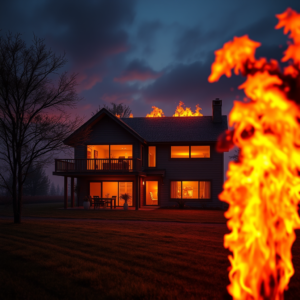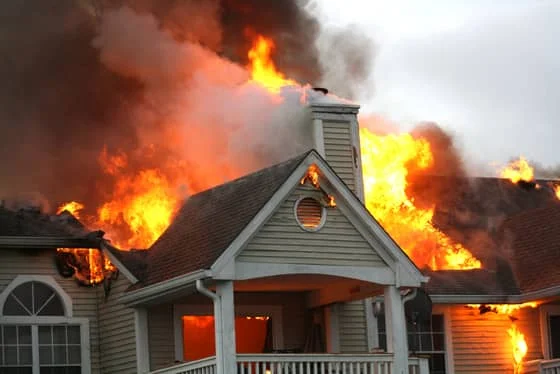 How do most house fires start? In recent times, the issue of house fires has been recognized and it bears witness to the need for fire safety education. According to statistics, the year 2022 saw around 343,100 household fires recorded in the United States leading to a property loss estimation of over 10.5 billion dollars and the death of 2,610 people. Cooking is the main cause, and accounts for almost 50% of the above mentioned incidents. As winter season approaches which is characterized by a prolonged upsurge in incidences of fire outbreaks, it useful to make sure that you are abreast with and even prepared for the situation. As these statistics and above mentioned reports depict, it is easy to conclude that a fire is always a threat and this emphasizes even more the need to have a dependable fire prevention technology in place to keep the family and property safe.
How do most house fires start? In recent times, the issue of house fires has been recognized and it bears witness to the need for fire safety education. According to statistics, the year 2022 saw around 343,100 household fires recorded in the United States leading to a property loss estimation of over 10.5 billion dollars and the death of 2,610 people. Cooking is the main cause, and accounts for almost 50% of the above mentioned incidents. As winter season approaches which is characterized by a prolonged upsurge in incidences of fire outbreaks, it useful to make sure that you are abreast with and even prepared for the situation. As these statistics and above mentioned reports depict, it is easy to conclude that a fire is always a threat and this emphasizes even more the need to have a dependable fire prevention technology in place to keep the family and property safe.
Understanding the Nature of Fire
We often overlook the significance of fire as an element but it can be very destructive as well. In order to know how do most fires start, one should first understand the fire triangle. A fire can start and be sustained only if three components are present – heat, fuel source and oxygen. Eliminating any one of these components would result in extinction of a fire.
The study of how things catch fire and how the fire continues to exist is indeed very interesting to note. The process of applying heat to the solid in order to cause it to burn produces certain materials in gaseous form. These gases will circulate in the air that has oxygen, and after a certain ambient temperature is reached, they will cause combustion – a chemical process that involves the production of flames.
Every fire begins with an ignition source. It could be a small spark or a gradual build-up of heat. The key to preventing house fires lies in recognizing these sources and eliminating them before they can cause harm.
Where Do Most House Fires Start?
House fires can start in various places, but some areas are more prone than others. According to data, kitchens, living rooms, bedrooms, and garages are the most common sites of origin. Each area presents unique risks.
Kitchens are notorious for fire hazards. Given the presence of open flame, hot surfaces, and combustible materials, it is no surprise that many fires originate from here. Cooking that is left unattended is the primary factor for kitchen fires which often leads to major destruction in property.
Living rooms are another heating facilities are no exception since they too experience frequent electrical powers outages which result in fires. A split second of poor decision making or judgement such as carelessly placing an electric heater in close range to flammable surfaces may have disastrous results.
Bedrooms present their own fire risks, with smoking materials being a common culprit. It’s easy to underestimate the danger of a smoldering cigarette, but it can quickly ignite bedding or furniture.
Garages often house flammable liquids and equipment that can spark a fire. Improper storage of fuels or failure to maintain tools can create a hazardous environment.
Causes of House Fires
To prevent a house fire, we must first understand the causes. Common household items and behaviors can ignite fires, often unexpectedly.
Cooking Equipment is a leading cause, especially when left unattended. Grease fires can escalate rapidly, engulfing a kitchen in flames.
Heating Appliances Heat sources such as portable heaters and heating appliances with chimney flues always pose dangers in their use. The improper use and the breakdown of these appliances may lead to devastating fires, notably in the winter season.
Electrical Faults are responsible for many fires, often due to outdated wiring or overloaded circuits. Ensuring electrical systems are up to code can prevent these incidents.
Smoking Materials, such as cigarettes, are another common cause. Falling asleep with a lit cigarette is a recipe for disaster, potentially igniting furniture or bedding.
Prevention and Safety Measures
Preventing house fires requires vigilance and preparation. Smoke detectors are an important safety measure as they will notify the residents of a potential threat before the threat fully develops. The periodic cleaning and testing of these smoke alarm systems also make sure that they work when they are most needed.
Creating a family fire escape plan is vital for safety. Everyone in the household should know at least two exit routes and a meeting place outside. Practicing this plan regularly can save lives during an emergency.
Learning the correct way to use a fire extinguisher is yet another essential skill. Using the extinguisher without delay saves time and stops a small fire from escalating to a disaster.
Regular maintenance of household items is also essential. Checking wiring, cleaning chimneys, and servicing appliances can reduce fire risks significantly.
Conclusion
Knowing the most frequent causes of fire outbreak and location is imperative for the protection of oneself, their household and possessions. By understanding which areas are prone to fire hazards and correcting them, a home owner can greatly minimize his or her level of fire risk.
Implementing fire safety measures is not just a personal responsibility, it’s a community effort. Sharing knowledge and resources can prevent future fires and save lives.
Take action today to safeguard your home. Share this post with friends and family to raise awareness and encourage everyone to adopt fire safety practices. Together, we can make our homes safer for everyone.

